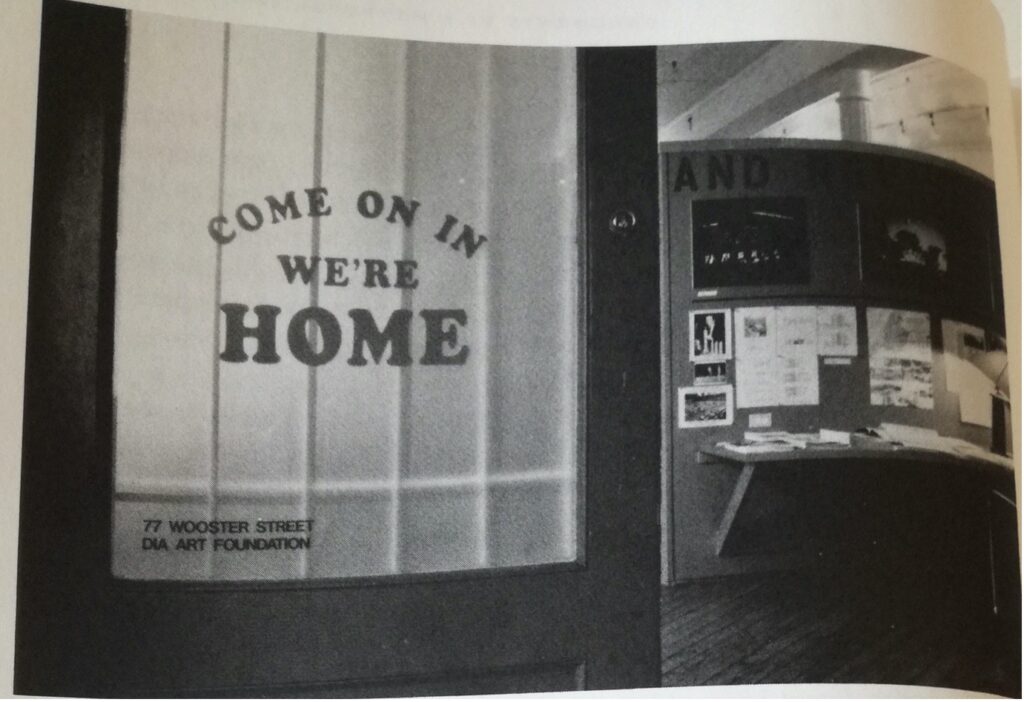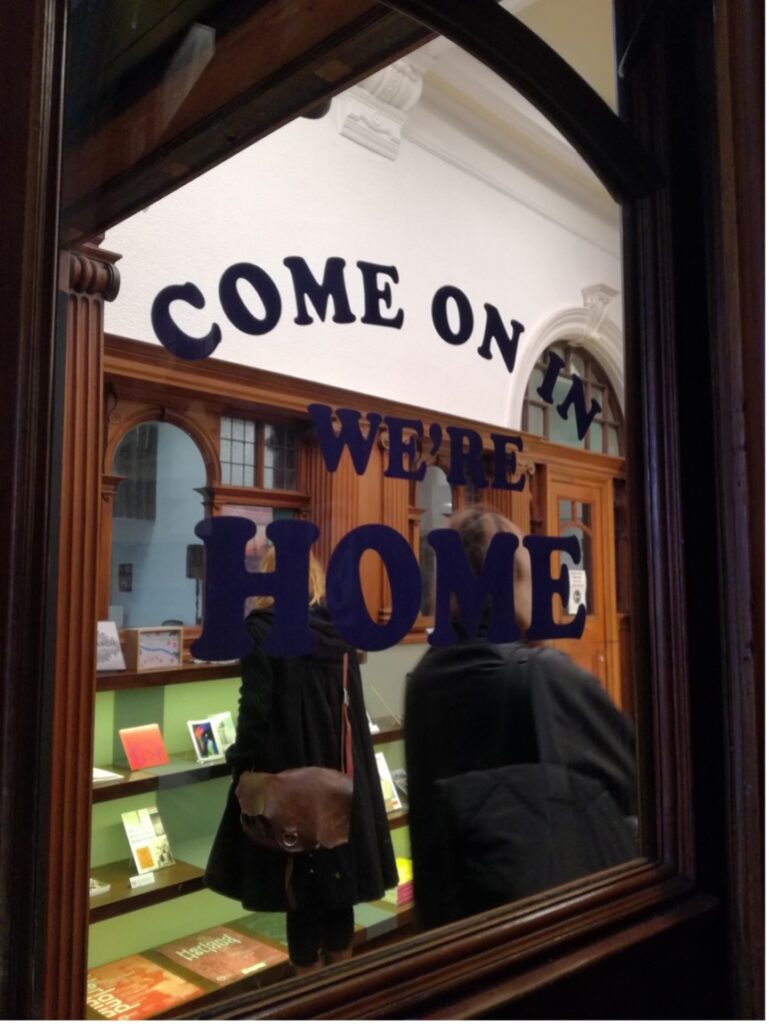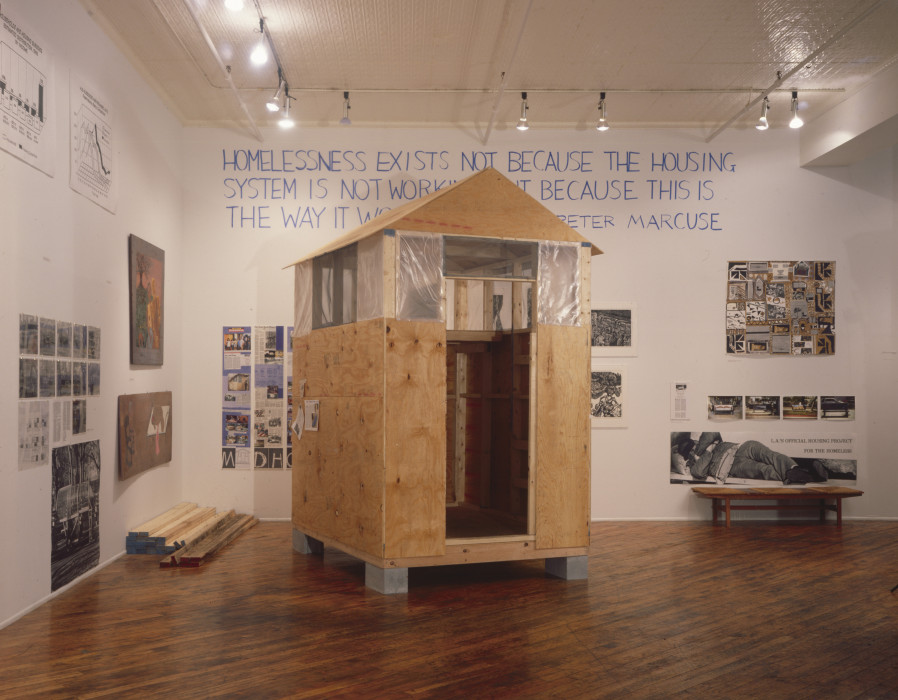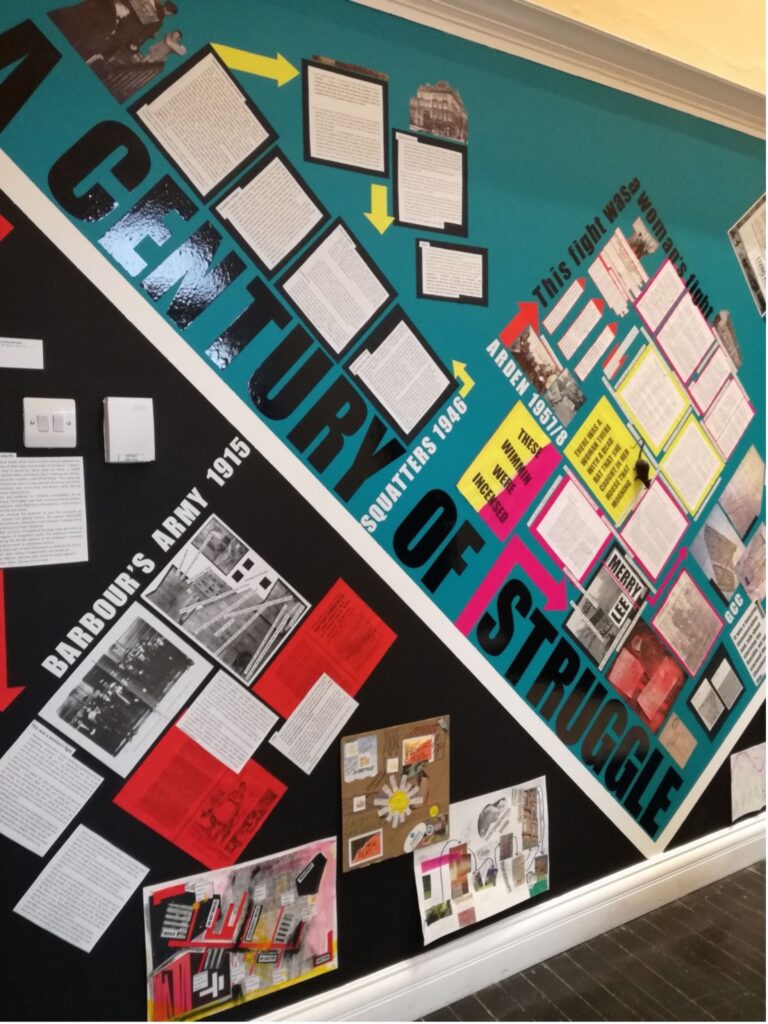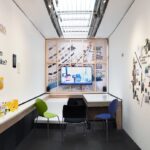In 2021, Glasgow Women’s Library (GWL) dedicated a room of its exhibition Life Support to an iteration of Martha Rosler (1989) If You Lived Here… This was a series of three exhibitions and four Open Forums about the housing crisis in NYC and a reflection on the role art played in the phenomena of divestment and gentrification (Rosler &Wallis, 1999). Reminiscent of the original project, the 2021 If You Lived Here… exhibition space was crammed with different materials exploring housing issues and forms of resistance. Aligned with the wider themes of Life Support, the GWL iteration looked at housing specifically from a feminist perspective in connection to issues of care and social reproductive labour.
What was unique about the Glaswegian curatorial project was the variety of timelines that intersected and interacted within the exhibition space.
From Rosler’s original programme, GWL displayed Docklands Community Poster Project (1981-91) photos of large-scale posters responding to the concerns of East London communities over extensive re-development programmes in the 1980s. It also included a graffiti quote by Peter Marcuse which was featured in Homeless: the Street and Other Venues, second of the three exhibitions by Rosler in 1989.
The exhibition also included historical archival materials owned by GWL. For example, it displayed documents from the women’s self-build collective housing project Take Root which imagined, designed, and fundraised for the construction of ideal alternative houses centred on women’s needs (Patrick, 1999).
New commissions, like Joey Simons and Keira McLean’s Glasgow Housing Struggle Timeline, were also part of the exhibition. This wall montage recovered histories of women-led actions for fairer housing and visualised a continuous timeline from 1915 struggles to current Living Rent ones. Working with GWL volunteers, the artists also intertwined in the montage contemporary timelines of housing struggles in response to GWL archival documents- which were exhibited alongside.
Lastly, visitors were invited to contribute to the exhibition by submitting responses to the prompt ‘What does home mean to you?’ through an online platform.
GWL IF YOU LIVED HERE AS A LIVING ARCHIVE
The Glaswegian If You Lived Here… is an excellent case study as it can be interpreted as a Living Archive: a curatorial framework that I would like to use to inform the development of our GRP project.
If You Lived Here… can be considered a Living Archive as, according to Sabiescu (2020), the core principle of this framework is the “performative celebration of the past through contemporary acts of creation and transmission.” If You Lived Here… demonstrates these qualities as its curatorial rationale states that the contemporary display “offers a way to connect with and learn from past struggles” (Gausde et al. 2021). This also exemplifies how exhibitions can be one way in which Sabiescu’s acts of creation and transmission can manifest.
Secondly, another characteristic of the Living Archive is its perpetual expansion with the acquisition of new materials. In the first place, GWL exhibition expresses this quality by inviting contributions from the public to broaden the exhibition content and the archival records. Additionally, the interpretation leaflet demonstrates that this exhibition is understood as a Living Archive as it states that since the original project “the If you Lived Here… archive has continued to grow and evolve […] accruing new materials along the way.” The curators also date If You Lived Here… “1989-present” showing how the GWL iteration is seen in continuity with the original exhibition (Gausde et al. 2021). Finally, the GWL display is understood as a still-evolving project as the curators state that the current show remains open to future developments and iterations (Gausde et al. 2021).
Within the framework of the Living Archive, two aspects are particularly important for our project. Firstly, the curatorial approach used to exhibit archival materials included in the Glaswegian exhibition. Secondly, the Living Archive’s ability to promote visitors’ engagement while challenging hierarchies of cultural value.
CURATORIAL APPROACH TO ARCHIVAL MATERIALS
The Living Archive is a useful curatorial framework to inform the development of our own project and respond to our brief as it presents exhibition-making as a form of knowledge production for existing collections and archives. Through a Living Archive framework, the exhibition has the ability to activate a collection by aligning different temporalities as it brings visitors and “memory-mediating texts [archival materials] into a co-located space” (Sabiescu, 2020). In the case of GWL original 1989 materials co-exist alongside contemporary works, in a space where the public is invited to continuously expand the records through their own contemporary submissions.
Furthermore, research led by Ketelaar (2001, 2005) shows how successive activations of an archive through communal remembrances- such as an exhibition- infuse the archive with layers of narratives. Ketelaar (2001, 2005) also underscores the contextual value of records, arguing that each activation in a different space confers new meaning and interpretations to archival materials in association with a new contemporary context (Sabiescu, 2020).
Therefore, adopting as a curatorial framework that of the Living Archive can allow us to produce new knowledge about the CRC collection materials exhibited, thanks to their activation in a different context: within Travelling Gallery and the locations we will visit.
THE LIVING ARCHIVE: PARTICIPATORY PRACTICES and CULTURAL DEMOCRACY
If You Lived Here…and its Living Archive also offer a framework for centring participatory practices within an exhibition space. GWL show had a specific focus on engagement by inviting visitors to contribute to the display by responding to the question ‘What does home mean to you?’ Through the visitors’ submissions, the exhibition challenged hierarchies of cultural value and it recognised the audience’s experiential knowledge (Bell, 1987; Delgado Bernal, 2002) as valuable as the artists’ fine art contributions. This exhibit, therefore, exemplifies a curatorial practice rooted in cultural democracy (Jancovich & Stevenson, 2023) defined as the redistribution of power over what constitutes valuable culture. To us, this curatorial framework is useful to develop an exhibition about housing that refutes a patronising attitude or a deficit approach (Yosso, 2005) towards our audience.
Inspired by this exhibition, we will invite visitors to take part in the display by submitting their answers to the question ‘What does your dream home look like?’ Through this submission form and the framework of the Living Archive, we aim to create an exhibition as a space of knowledge-exchange recognising individuals’ experiences as fundamental for a rich polyvocal curatorial narrative on housing.
While the framework adopted by GWL exhibition is incredibly valuable, in 2021 they were unsuccessful in gathering a significant amount of submissions from the public. Talking to Kirsten Lloyd, curator of the exhibition, she reflected that an introductory workshop to gather some initial responses may have encouraged other visitors to take part. To mitigate the lack of participation, we are planning on hosting a workshop and commissioning a zine by artists Joey Simons and Keira McLean to guide visitors in imagining their dream homes and taking part in the display.
BIBLIOGRAPHY
Bell, D. (1987) And we will not be saved: the elusive quest for racial justice (New York, Basic Books).
Delgado Bernal, D. (2002) Critical race theory, LatCrit theory and critical raced-gendered epistemologies: recognizing Students of Color as holders and creators of knowledge, Qualitative Inquiry, 8(1), 105–126.
Gausden, C., Lloyd K. Spencer C. and Raha N. (2021) Life Support- Forms of Care in Art Activism-Exhibition guide. Glasgow: Glasgow Women’s Library.
Jancovich, L. & Stevenson, D. (2023) Failures in Cultural Participation. [Online]. Cham: Springer Nature.
Ketelaar, E. (2001) Tacit narratives: The meanings of archives. Archival Science. [Online] 1 (2), 131–141.
Ketelaar, E. (2005) Sharing: Collected Memories in Communities of Records. Tijdschrift Voor Nederlandse Taal-en Letterkunde. [Online]
Lloyd, K. (2017) ‘If You Lived Here…: A Case Study on Social Reproduction in Feminist Art History’, in Feminism and Art History Now. [Online]. I.B.Tauris & Co. Ltd. pp. 183–202.
Rosler, M. & Wallis, B. (1999) If you lived here : the city in art, theory, social activism : a project / by Martha Rosler ; edited by Brian Wallis. No 6 : If you lived. New York: New Press.
Sabiescu, A. G. (2020) Living Archives and The Social Transmission of Memory (New York, N.Y.). [Online] 63 (4), 497–510.
Yosso, T. J. (2005) Whose culture has capital? A critical race theory discussion of community cultural wealth. Race, ethnicity and education. [Online] 8 (1), 69–91.

